Tweaks for Geeks
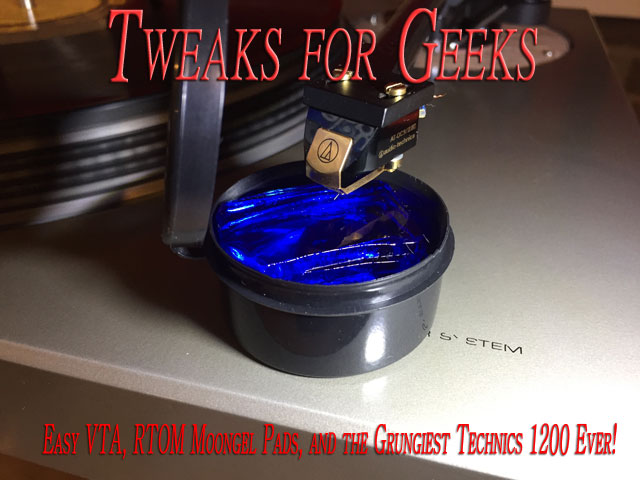
Cheap Goodies
 It seems like I’ve done a lot of reviews over the last few months, or at least enough to feel like I’ve been really busy. But as Spring rolled up I suddenly found myself with nothing on the docket, not immediately anyway. Due to an unforeseen disaster, and then using my 50th birthday as self-indulgent excuse, I ordered myself a new SOTA Nova VI that should arrive sometime in April. I’m also expecting another turntable for audition around the same time, so the lull will be short-lived. Both tables will be reviewed, but as of this writing there’s nothing in my system except my own gear and it’s been a while since that happened.
It seems like I’ve done a lot of reviews over the last few months, or at least enough to feel like I’ve been really busy. But as Spring rolled up I suddenly found myself with nothing on the docket, not immediately anyway. Due to an unforeseen disaster, and then using my 50th birthday as self-indulgent excuse, I ordered myself a new SOTA Nova VI that should arrive sometime in April. I’m also expecting another turntable for audition around the same time, so the lull will be short-lived. Both tables will be reviewed, but as of this writing there’s nothing in my system except my own gear and it’s been a while since that happened.
That doesn’t mean that nothing has been going on at chez Simmons, though. There are a couple of new doodads I’ve been meaning to write about for a while, each too small for an entire article which got them to get bumped while bigger projects took precedence. I also rebuilt another turntable and it turned out so well I thought it was worth sharing, particularly because it was done on a table that’s so common almost anyone could do it.
Among the other benefits of the lull in reviews: no dragging gigantic, heavy boxes to or from UPS, or worrying about whether anything was damaged in transit by the Butchers in Brown.
My back is feeling better already.

Tweak One: RTOM Moongel Damping Pads.
 Vinyl accessories are like pet products. Take two identical products; slap a cute animal on the side of one of them, sell it in a pet store, and the price for that item goes up four-fold. A litter pan for your cat costs about $15. Go to Home Depot and buy a low, flat plastic storage container of similar size – effectively the same thing – and it’ll set you back about $4, saving you about 75% of your hard-earned bread. Everyone wants to feel like they’re pampering Fluffy, but nobody cares about a container for storing winter socks. Respective prices reflect these attitudes and you can use this to your advantage.
Vinyl accessories are like pet products. Take two identical products; slap a cute animal on the side of one of them, sell it in a pet store, and the price for that item goes up four-fold. A litter pan for your cat costs about $15. Go to Home Depot and buy a low, flat plastic storage container of similar size – effectively the same thing – and it’ll set you back about $4, saving you about 75% of your hard-earned bread. Everyone wants to feel like they’re pampering Fluffy, but nobody cares about a container for storing winter socks. Respective prices reflect these attitudes and you can use this to your advantage.
A popular vinyl accessory is the Onzow Zerodust, an inch-and-a-half square plastic box with a detachable magnifying cover and a small sticky pad of gel inside. Set the little box on the platter of your turntable and lower the stylus onto the gel. Any needle schmutz sticks to the pad and the stylus emerges goo-free, clean and ready to play. Lots of people use them and they work quite well. I’ve had one for years.
They don’t last forever, though, and eventually the pad loses its tack and stops working, which is what happened to mine. I found myself looking for a replacement.
The Zerodust has one major drawback: its price. It’s a tiny bit of plastic with a little gel in it and it costs $40, which has always seemed really expensive for what actually comes in the package. I’m kinda cheap, so when it came time to find a replacement, I looked around to see if there were any more cost-effective alternatives and I found one.
On a couple of the online forums people recommended RTOM Moongel Damping Pads as a substitute, and I’m adding my voice to the chorus. These are not specifically a turntable product, though they are music related. Their stated purpose is to damp resonance when affixed to the head of a drum. I’ve no idea if they’re any good for that, but coincidentally it appears they’re made of the same type of tacky gel as the Zerodust. Most importantly, they work just as well. Lift the stylus off the clear blue pad and you can see the dirt and grunge that’s left behind, except – like buying the cheap litter pan for your cat – you can congratulate yourself for being really smart because six Moongel pads in a re-sealable container costs only $6.99 and you’ve just saved thirty-three bucks.
I’ve been using the Moongel pads for a while on my Audio-Technica OC/9-III and Miyajima Spirit Mono cartridges and they work great. In fact, to make them even easier to use, I pulled the old pad out of the Zerodust box and replaced it with one of the new Moongels. This is not a strictly necessary step, but the Onzow box is shorter and easier to move around under the stylus. The box the Moongels come in works fine too.
There are a bunch of products that do comparable service. Magic Erasers certainly have their partisans, for example, and although I’ve never tried them, they probably work well, too. I like the Moongels for the same reason I liked the Zerodust. It’s an effective, compact tool that’s easy to maneuver around an expensive cartridge. Best of all, the Moongels are one-sixth the price of a Zerodust for six times as many pads. In a hobby with very few genuine bargains this is definitely one of them.
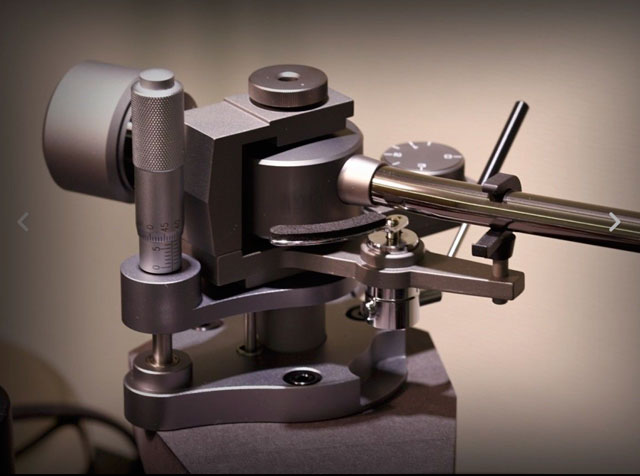
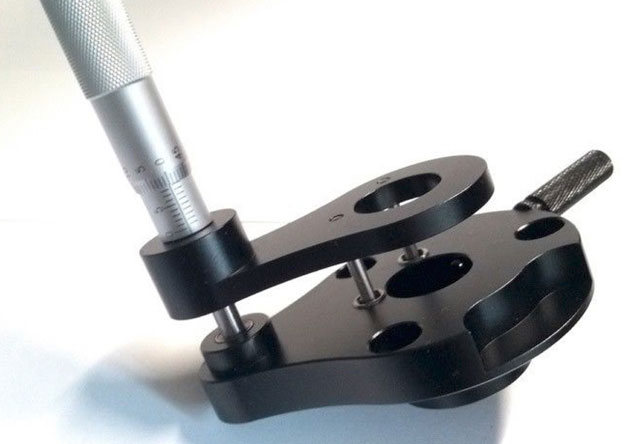
Tweak Two: Easy VTA for Jelco Tonearms
 On my SOTA turntables – the former and the forthcoming – I’ve always had Jelco or Jelco-based tonearms. An AudioQuest PT-6 came with my Star-Sapphire, and I upgraded that to the Jelco SA-750db about four years ago. I like the Jelco arms and it’s my intention to reinstall one on my new Nova.
On my SOTA turntables – the former and the forthcoming – I’ve always had Jelco or Jelco-based tonearms. An AudioQuest PT-6 came with my Star-Sapphire, and I upgraded that to the Jelco SA-750db about four years ago. I like the Jelco arms and it’s my intention to reinstall one on my new Nova.
The Jelco arms are one of the great bargains in hi-fi. My SA-750 was under $500 new in the box when I bought it and it proved to be a rather dramatic improvement for that turntable: a significantly larger and taller sonic presentation with tighter images and better bass. It’s no wonder that some big names in analog modify and rebadge Jelco arms as their own. Ortofon does so currently, but in the past they’ve also been rebranded by AudioQuest, Sumiko, Koetsu, and others, and almost always at higher prices than if you simply bought a Jelco branded arm. Jelco doesn’t appear to have U.S. distribution for some reason, but Canadian company Audio Sensibility stocks them and can readily ship anywhere in America. That’s where mine came from.
As good as they are, the Jelco arms aren’t perfect. One of the oft-cited drawbacks is adjusting the vertical tracking angle. A grub screw through the mounting collar holds the arm shaft in place. To adjust the arm-height you open the grub screw, raise or lower the arm shaft by hand, then re-tighten the screw. The problem with this is twofold: first, it’s imprecise, necessitating that the user guestimate the proper position, then hold the arm perfectly still while re-setting the screw; and second, the grub screw will eventually leave indentations on the shaft, potentially forcing the arm slightly higher or lower than intended when the screw is tightened against an uneven surface. This was my experience with my PT-6, which has lots of silver divots showing through its black paint. It’s not a horrible system – it works well enough – but it’s not ideal and there was certainly room for improvement.
Antonio da Silva, a gentleman operating from an undisclosed location in the UK, began working on this problem as a hobbyist. He didn’t set out to create a commercially viable product; he just wanted an easier way to adjust his tonearm. What he came up with is the Easy VTA, which currently lists for $260 in the U.S. or about $200 if you order one directly from the UK through eBay.
The Easy VTA replaces the stock mounting collar assembly on SA series Jelcos with one that incorporates a horizontal threaded knob in place of the grub screw and a vertical micrometer spindle that actuates a second collar that sits under the main bearing of the tonearm. Turning the vertical spindle raises or lowers the collar smoothly – and the main bearing assembly with it – raising or lowering the arm to facilitate accurate adjustments. And, because the user is not simultaneously trying to hold the arm up by hand, one can actually see the angle of the arm and cartridge from a good horizontal vantage point. The micrometer makes any setting easily repeatable for those prone to swapping cartridges. The horizontal knob locks it all back into place when the desired VTA is achieved. In the metal, it’s a lovely bit of solid aluminum machine work with very precise tolerances and absolutely no slop in the moving bits.
 Unfortunately, as delivered it didn’t quite fit on my turntable. SOTAs have an armboard that’s sunken by about half an inch which created two problems: First, the range of the Easy VTA was too low to bring the tonearm up to level over the platter, and second, the horizontal knob – which is over an inch long – stuck out too far, making contact with the side of the armboard well.
Unfortunately, as delivered it didn’t quite fit on my turntable. SOTAs have an armboard that’s sunken by about half an inch which created two problems: First, the range of the Easy VTA was too low to bring the tonearm up to level over the platter, and second, the horizontal knob – which is over an inch long – stuck out too far, making contact with the side of the armboard well.
Undeterred, I did a little improvisation. To get the arm up to a usable height I installed three quarter-inch nylon bushings between the base and the armboard with the mounting bolts running through them. This raised the mounting collar enough to properly adjust the VTA.
Now, I can hear someone screaming that by de-coupling the arm from the arm-board I’d likely created some sonic detriment, but that wasn’t the case. In fact, if anything it was quite the opposite as I’ll get to in a moment.
The horizontal knob required a more medieval solution. It needed to be about one-third of an inch shorter to clear the side of the well. I have a hacksaw, so the knob fits fine now. This may make me the Lizzie Borden of turntable setup.
Turntables with arm-boards that are flush on the surface – which includes the vast majority of tables – should experience none of these problems. A shorter side knob and perhaps a collar spacer to accommodate turntables with sunken arm-boards would be nice.
I’ll state at this point that the value in the Easy VTA goes beyond the functional ease of adjusting tracking angle. It actually did improve the sound of the arm. The second collar supporting the bearing adds rigidity and as a result images became more tightly focused and detailed. If there was any penalty for having the nylon spacers installed it certainly didn’t outweigh the audible improvements. In fact, the spacers may have served to further isolate the arm from mechanical resonance created by the turntable itself. The change was positive and clearly audible and, forgetting about the ease of adjustment, the sonic improvements alone are worth the price of admission.
Also, the Easy VTA does – as advertised – make adjusting proper vertical tracking angle…well…easy, even for something as tweaky as compensating for varying thicknesses between vinyl pressings. I’m not that obsessive, so I don’t do a lot of that, but you could. The Easy VTA is simple and stable enough that it can be adjusted even when a record is playing.
Jelco tonearms are popular because they sound really good and because they’re among the greatest values in hi-fi. The Easy VTA is an affordable upgrade for Jelco arms that also pays a real sonic dividend. It’s easy to install, easy to use, and easy to recommend. Seriously, if you’ve got a Jelco SA series arm or one of its variants, check one of these out. You won’t be sorry.
Stereo Dreams
 I miss my SOTA. My thirty-year-old Star-Sapphire got shipped off to Wisconsin for some modifications this past January, only to be destroyed in transit. Now I’m waiting for my new Nova 6 to arrive and it’s just killing me. I’m sure it’ll be worth the wait, but c’mon, c’mon, c’mon, hurry, hurry, hurry!
I miss my SOTA. My thirty-year-old Star-Sapphire got shipped off to Wisconsin for some modifications this past January, only to be destroyed in transit. Now I’m waiting for my new Nova 6 to arrive and it’s just killing me. I’m sure it’ll be worth the wait, but c’mon, c’mon, c’mon, hurry, hurry, hurry!
I went a good two months relying on my Rek-O-Kut T12h, listening solely to monaural records augmented by a few CDs, but eventually the gap in stereo playback required some drastic measures. The grungy Technics SL-1200 Mk 1 that had been sitting on a shelf in my listening room for over a year started to look appealing.
The Tech-12 was my original mono deck before the Rek-O-Kut was running. This is the original Mark I version, which had an actual on/off switch and knobs to adjust the speed, not the more familiar buttons and sliders from the subsequent forty-years of production. In the plus column, it has the same motor as the original Technics SP-10 broadcast table, so there are some good genes in there.
I found this one at a flea market for a hundred bucks and it may have spent time buried in someone’s flowerbed. It was badly oxidized, some of the adjustments were fused solid, and speed stability was, well… unstable… to say the least. The arm – the old-style S-shaped contraption held over from the 1100 – was garbage: an imprecise, horribly resonant, tin tube, even after I’d restored all of its functions. But, it did what I needed it to do for a while when I bought it, and that was enough.
Sitting unused for a year after deploying the Rek-O-Kut had done nothing to improve either the Tech-12’s rotational stability or the quality of the arm. When I plugged it back in this past February the platter would randomly slow to a complete stop in the middle of a record, then spring back to life unprompted. It was a bit freaky. No one would have batted an eye if I’d simply tossed this thing in the rubbish bin.
Nevertheless, musical desperation sometimes necessitates extraordinary measures, and while this beater Tech-12 didn’t have a lot left to recommend it, I really wanted to listen to a stereo record or two. It clearly needed some serious work. I figured that if I destroyed it in the process, well, it was close to flatline anyway so it wouldn’t be a big deal. I’d never worked on any other turntable besides my Rek-O-Kut – and particularly nothing with a circuit board – but I had a free weekend and I like a challenge, so I decided to tear it down to see if a good cleanout could get it running well enough to use, at least in the short term.
I’d never seen the inside of it, so I wasn’t sure what to expect. Opening it required removing a lot of small screws and then marking a few internal components so I’d know how to get them all back together. I sprayed out all the speed control pots and on/off switches with contact cleaner and opened the motor housing to clean all its points, careful not to knock off any of the fine wires that circle the inside. I also cleaned out the bearing and scrubbed the top plate. While I had it open, I took the opportunity to strategically install some Dynamat to damp the chassis.
This early Technics proved very easy to work on. Even the patterns on the plugs between the motor, switches and circuit board are spaced so they can only be attached the way they’re intended. It’s almost idiot proof, unless you accidentally knock a small Tupperware container full of those tiny screws across the shop, then spend an hour and a half of crawling around on the floor trying to find them… but I don’t know anyone (*ahem*) who’d do something that stupid.
Like I said: almost idiot proof.
All these efforts were rewarded with renewed speed stability and the complete elimination of the random stopping issue. Now screwed back together, this early Tech-12 does require speed adjustment more often than the later quartz lock models, but only a little and very infrequently. It runs smoothly and silently and is easily dialed in using the strobe marks on the side of the platter. So far, so good.
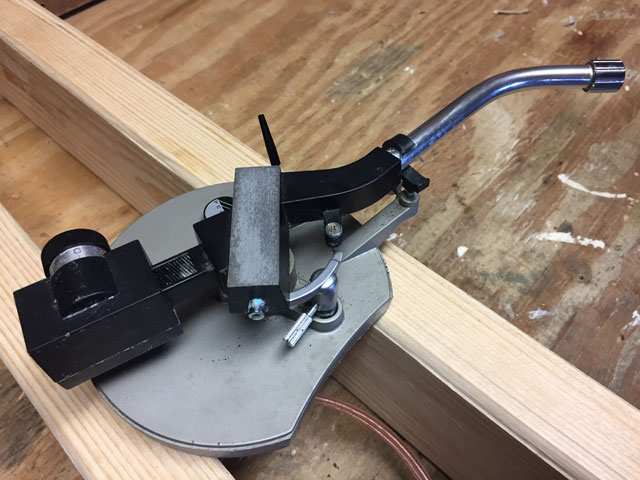
Then there was that wretched arm.
Once the mechanicals were rebuilt, I ran the table for a week with an Audio-Technica OC/9-III cartridge installed on the factory arm. I’ve had one version or other of the OC/9 in my system for a decade and this was hands down the worst I’d ever heard this cartridge. Images were blurred, bass was wooly; it just sounded terrible. The stock arm might best be described as a ‘no-mass’ design, likely intended for moving magnet cartridges with wet noodle compliance; not good with a moving coil, no, not good at all.
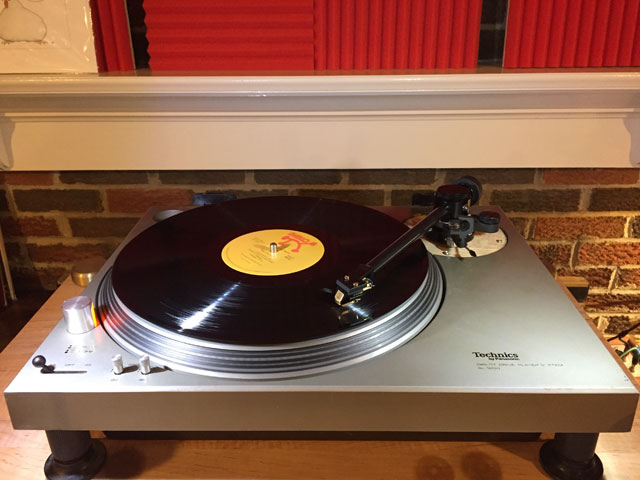
Digging around in the closet of unused hi-fi treasures – a jumble of boxes containing cables, random parts, and old vacuum tubes – I found a thirty-year-old AudioQuest PT-6 arm, still in its original box with all its pieces. I scrubbed in for the transplant, cut a new arm-board out of a half-inch oak plank, drilled the appropriate 210mm hole, and used the stock machine screws to affix it to the original threaded mounting points in the turntable, except from the top instead of from underneath. I re-installed the OC/9, hit the patient with some electricity, and like Frankenstein (in Young Frankenstein, of course) this old Tech-12 started to dance.
So, how’s it sound, you ask? Frankly, it’s shockingly good: clear, lively, stable and reasonably three-dimensional. It doesn’t have the refinement or bass solidity of my SOTA, and the soundstage isn’t as big, but otherwise it’s far better than passably listenable. I paid essentially nothing for this table. With the cleanout and the new arm, it now sounds every bit as good as any turntable I’ve heard under $1,000. I’m enthusiastically enjoying it.
Obviously pleased with the outcome, I shot an email to AudioQuest VP Joe Harley to ask about the arm. I knew the PT-6 was based on an older Jelco design but not much else. Joe told me that back in the day AQ had sourced it from Jelco but upgraded it with their proprietary wire and special damping material applied to the arm-tube to quell resonance. Whatever they did it worked well, and the improvements had staying power. The PT-6 really transformed this deck from a thorough mediocrity into a really good turntable.
When my new SOTA finally arrives, I’m going to keep this Frankenstein Tech-12 up and running. Maybe I’ll get a more modest moving-magnet cartridge and use it as a budget reference. After all, you can’t have too many turntables, and this Tech-12, along with the SOTA and Rek-O-Kut, only brings me up to three. When it comes to spinning records, too many turntables are never enough.
Wrap up
Sometime in the next month or so I expect to have my new SOTA Nova VI here and spinning records. I’m excited about that and that’ll be a big upcoming review. But in the interim, rebuilding the Tech-12 proved to be a worthwhile exercise. The nice thing about using these turntables for a project like this is that there are thousands of them around. It wouldn’t be that hard to find one for a good DIY project. In fact I’m going to keep my eyes open for a later model with the quartz lock – especially one with a broken arm. I’d like to do another one.
Reviewing audio gear sometimes seems like jumping from one impossibly expensive component to the next, but it’s always worthwhile to share a few of the little tweaks that make it all easier, especially if they’re cheap enough that anyone can play. The space between major equipment reviews also afforded a good opportunity to focus on these worthwhile budget tweaks. The Moongel and the Easy VTA both products that fall in that category. Both highly recommended.


greg simmons
Stereo Times Masthead
Publisher/Founder
Clement Perry
Editor
Dave Thomas
Senior Editors
Frank Alles, Mike Girardi, Key Kim, Russell Lichter, Terry London, Moreno Mitchell, Paul Szabady, Bill Wells, Mike Wright, Stephen Yan, and Rob Dockery
Current Contributors
David Abramson, Tim Barrall, Dave Allison, Ron Cook, Lewis Dardick, Dan Secula, Don Shaulis, Greg Simmons, Eric Teh, Greg Voth, Richard Willie, Ed Van Winkle, and Rob Dockery
Music Reviewers:
Carlos Sanchez, John Jonczyk, John Sprung and Russell Lichter
Site Management Clement Perry
Ad Designer: Martin Perry



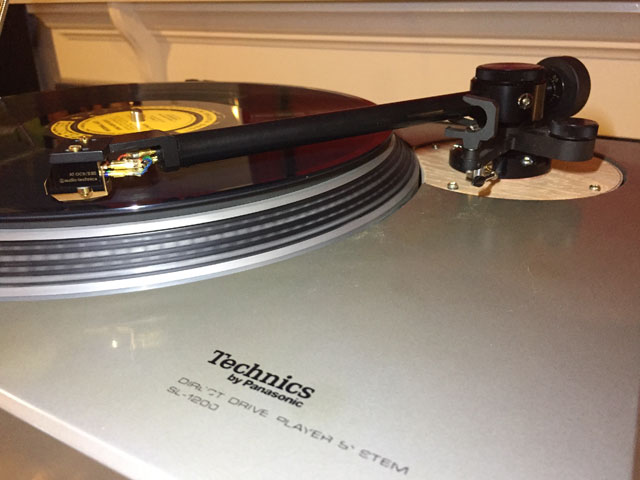



Be the first to comment on: Tweaks for Geeks